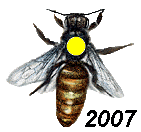The imirie Shim is the invention of the late George Imirie to which he attributes much of his success. There are a variety of uses but the most important is to add shims between extracting supers during the honey flow to provide upper entrances. They also add extra ventilation over the winter, more space for patties, mite treatments, or queens. Imirie shims are 3/4 inch thick with an entrance hole. DO NOT USE WITH FOUNDATION WITH THE IMIRIE SHIM. An Imirie Shim is never used anywhere on a colony except in between supers (never in the brood area). Put a Shim between the 1st and 2nd supers and another one between the 3rd and 4th supers; if you cut an additional entrance in the inner cover, the bees will have 3 entrances to use other than the bottom board entrance: 2 Imirie Shims + the entrance cut in the inner cover. This are easily made, see the DIY section for a plan. Also available HERE.
Proper Use of the Imirie Shim
Ever since my shim was endorsed and put on the commercial market, many users have contacted me by phone, E-mail, or letter asking me for advice about some problem with their beekeeping; and they use their purchase of the shim as a "justification" for contacting me. Let me say LOUD AND PUBLICLY that no one needs any justification to ask me for help with their bee problems provided that they are indeed attempting to UPGRADE their knowledge, and not to argue the merits of the BEST bee, annual or biennial requeening, or the use of Terramycin.
However, I have found that many of these inquirers are using the shim for some purpose that has little to do with its intended purpose and hence my reason for its use; and then I am chastised or insulted that the shim "does not work" or it "makes new problems". The ONLY purpose for the shim is to relieve brood chamber congestion by providing ingress and egress to the SUPER AREA and the shim should only be on a colony when supers are in place! It should NOT BE USED in the BROOD AREA! It should NOT BE USED as an upper entrance in the fall or winter. It should not be used between supers of FOUNDATION (which is far different from DRAWN COMB). The shim should never be in contact with a queen excluder!
The proper use of a shim is as follows: Use with supers of DRAWN COMB only. Put 2 supers over the queen excluder, then add a shim, add a 3rd and a 4th super, then add another shim, add a 5th super, install the inner cover that has an upper entrance made into the edge of it, and top this off with the telescoping cover and a brick..
The shim is 3/4" inch high, and hence its placement is defying the "rules" of BEE SPACE, and bees will build BURR comb on top of frames if the shim is used IMPROPERLY, particularly if it is used in the brood area. If the shim is placed between supers of FOUNDATION, the bees (having no construction blueprints) will build burr comb within the 3/4" inch space of the shim, and "weld" the upper super to the lower super with burr comb as they draw foundation.
Lastly, and this should be very instructional for some readers: If you are using DRAWN COMB in your supers, but you are still getting burr comb built in the shim space, the bees are really trying hard to tell you something, and that is: WE NEED MORE SUPER SPACE! It is hard work, time consuming, and requires a lot of nectar EATING for bees to build comb; and, hence, if your bees have plenty of drawn comb super space for them to temporarily unload lots of nectar for storage until they can ripen it into thick honey, the bees will not trouble themselves to build burr comb in the shim area between supers of empty drawn comb!
I have been using my shim for 30-40 years on all my colonies supered for extracted honey production with little or no burr comb construction; and it materially helps in the two things I designed it to do: Aid in swarm prevention because it relieves brood chamber congestion from forager bees, and increases honey production because foraging bees can enter and leave the colony via the shim entrances directly into the super area faster than using the bottomboard entrance.
Install shims when supers are installed, and remove shims when supers are harvested.
George Imirie Certified EAS Master Beekeeper











